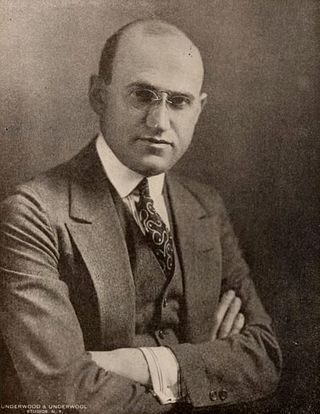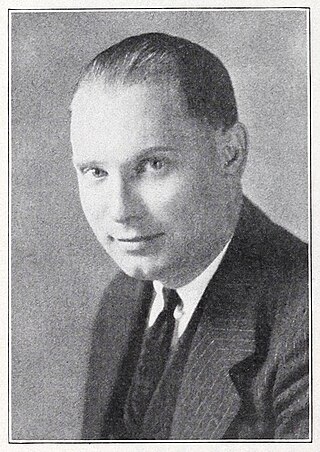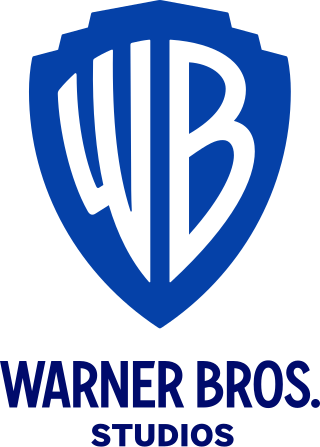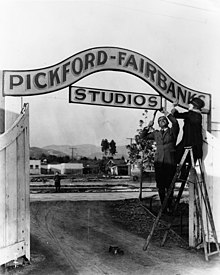
Gladys Marie Smith, known professionally as Mary Pickford, was a Canadian-born American actress, producer, screenwriter and film studio founder, who was a pioneer in the US film industry with a Hollywood career that spanned five decades. She was notable for working in the films of director D.W. Griffith.

Warner Bros. Entertainment Inc. is an American film and entertainment studio headquartered at the Warner Bros. Studios complex in Burbank, California, and a subsidiary of Warner Bros. Discovery. Founded in 1923 by four brothers, Harry, Albert, Sam, and Jack Warner, the company established itself as a leader in the American film industry before diversifying into animation, television, and video games, and is one of the "Big Five" major American film studios, as well as a member of the Motion Picture Association (MPA).

Metro-Goldwyn-Mayer Studios, Inc., also known as Metro-Goldwyn-Mayer Pictures and abbreviated as MGM, is an American film, television production, distribution and media company owned by Amazon through MGM Holdings, founded on April 17, 1924, and based in Beverly Hills, California.

United Artists Corporation (UA), doing business as United Artists Digital Studios, was an American production and distribution company. Founded in 1919 by D. W. Griffith, Charlie Chaplin, Mary Pickford, and Douglas Fairbanks, the studio was premised on allowing actors to control their own interests, rather than being dependent upon commercial studios. UA was repeatedly bought, sold, and restructured over the ensuing century. Metro-Goldwyn-Mayer (MGM) acquired the studio in 1981 for a reported $350 million.

Major film studios are production and distribution companies that release a substantial number of films annually and consistently command a significant share of box office revenue in a given market. In the American and international markets, the major film studios, often known simply as the majors or the Big Five studios, are commonly regarded as the five diversified media conglomerates whose various film production and distribution subsidiaries collectively command approximately 80 to 85% of U.S. box office revenue. The term may also be applied more specifically to the primary motion picture business subsidiary of each respective conglomerate.

An independent film, independent movie, indie film, or indie movie is a feature film or short film that is produced outside the major film studio system, in addition to being produced and distributed by independent entertainment companies. Independent films are sometimes distinguishable by their content and style and the way in which the filmmakers' personal artistic vision is realized. Usually, but not always, independent films are made with considerably lower budgets than major studio films.

Samuel Goldwyn, also known as Samuel Goldfish, was a Polish-born American film producer. He was best known for being the founding contributor and executive of several motion picture studios in Hollywood. He was awarded the 1973 Golden Globe Cecil B. DeMille Award, the Irving G. Thalberg Memorial Award (1947) and the Jean Hersholt Humanitarian Award (1958).
Turner Entertainment Company is an American multimedia company founded by Ted Turner on August 2, 1986. Purchased by Time Warner on October 10, 1996 as part of its acquisition of Turner Broadcasting System (TBS), the company was largely responsible for overseeing the TBS library for worldwide distribution. In recent years, this role has largely been limited to being the copyright holder, as it has become an in-name-only subsidiary of Warner Bros., which currently administers their library.

The Formosa Cafe is a restaurant and bar founded in 1925 and located at 7156 Santa Monica Boulevard at the intersection with North Formosa Avenue, in West Hollywood, California.
The Samuel Goldwyn Company was an American independent film company founded by Samuel Goldwyn Jr., the son of the famous Hollywood mogul, Samuel Goldwyn, in 1978.

Twentieth Century Pictures, Inc. was an independent Hollywood motion picture production company created in 1933 by Joseph Schenck and Darryl F. Zanuck from Warner Bros. Financial backing came from Schenck's younger brother Nicholas Schenck, president of Loew's, the theater chain that owned Metro-Goldwyn-Mayer (MGM), Louis B. Mayer of MGM, who wanted a position for his son-in-law, William Goetz, Bank of America and Herbert J. Yates owner of the film processing laboratory Consolidated Film Industries, who later founded Republic Pictures Corporation in 1935. . The company product was distributed by United Artists (UA), and leased space at Samuel Goldwyn Studios.

The Sony Pictures Studios is an American television and film studio complex located in Culver City, California at 10202 West Washington Boulevard and bounded by Culver Boulevard (south), Washington Boulevard (north), Overland Avenue (west) and Madison Avenue (east). Founded in 1912, the facility is currently owned by Sony Pictures and houses the division's film studios, such as Columbia Pictures, TriStar Pictures, and Screen Gems. The complex was the original studios of Metro-Goldwyn-Mayer from 1924 to 1986 and Lorimar-Telepictures from 1986 to 1989.
Samuel Goldwyn Productions was an American film production company founded by Samuel Goldwyn in 1923, and active through 1959. Personally controlled by Goldwyn and focused on production rather than distribution, the company developed into the most financially and critically successful independent production company in Hollywood's Golden Age.

Sunset Gower Studios is a 14-acre (57,000 m2) television and movie studio at the corner of Sunset Boulevard and Gower Street in Hollywood, California. Established in 1912, it continues today as Hollywood's largest independent studio and an active facility for television and film production on its twelve soundstages.

M.C. Levee was born Michael C. Levee.

The Warner Bros. Ranch is located at 411 North Hollywood Way in Burbank, California and was formerly called the Columbia Ranch. It was the backdrop for many Columbia Pictures films and Screen Gems/Columbia Pictures Television shows, including Father Knows Best, The Donna Reed Show, Dennis the Menace, Hazel, Bewitched, Gidget, I Dream of Jeannie, The Monkees, The Flying Nun, Here Come the Brides, The Partridge Family, The Hathaways, The Waltons, Lost Horizon, High Noon, Mr. Deeds Goes to Town, You Were Never Lovelier, Lethal Weapon, National Lampoon's Christmas Vacation, WandaVision, The Wild One, The Wrecking Crew and Autumn Leaves. Only the front facades of the houses and buildings were built; the interiors were always shot at other locations or studios. The streets were constructed and arranged to allow shooting at multiple angles to create the illusion of a much larger area, though the lot only spans about six city blocks.
Ben Carré (1883–1978) was a French art director and painter who settled in the United States. He designed sets for dozens of Hollywood films including The Blue Bird, The Phantom of the Opera, Don Juan, The Jazz Singer, and A Night at the Opera. He was a founding member of the Academy of Motion Picture Arts and Sciences.

Warner Bros. Studios, Burbank, formerly known as First National Studio (1926–1929), Warner Bros.-Seven Arts Studios (1967–1970) and The Burbank Studios (1972–1990), is a major filmmaking facility owned and run by Warner Bros. Entertainment Inc. in Burbank, California. First National Pictures built the 62-acre (25 ha) studio lot in 1926 as it expanded from a film distributor to film production.

Warner Bros. Pictures is an American film production and distribution company of the Warner Bros. Pictures Group division of Warner Bros. Entertainment. The studio is the flagship producer of live-action feature films within the Warner Bros. Pictures Group unit, and is based at the Warner Bros. Studios complex in Burbank, California. Animated films produced by the Warner Animation Group are also released under the studio banner.















